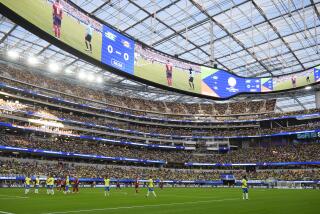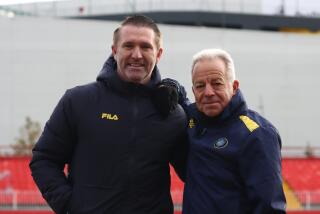COMMENTARY : The Spectacle Far Outshined World Cup’s Style of Soccer
- Share via
ROME — Bread and circuses. That’s what the Roman patricians used to rely on to keep the plebeian masses in order.
Things haven’t changed much in 2,000 years.
The bread is still bread, but the circus is now called calcio , or soccer. Italians have taken to the sport like no other people on earth. It has become part of the fabric of society, as vital a component as its literature, art and music, its fine food and even finer wine.
For the past month, Italy has lived and breathed soccer, following the World Cup with a passion bordering on obsession. The 52 matches that ended with West Germany’s 1-0 victory over Argentina Sunday night have dominated newspaper columns and radio and television programs from one end of the Italian boot to the other.
Now it is over.
What will the world make of Italia ‘90? What is the verdict on this World Cup as compared to the previous 13 dating to 1930?
Perhaps it is too early to render a judgment. A lot will depend on whether the lessons of the tournament have been learned.
If soccer’s powers-that-be, namely the Federation International of Football Association, can find a way to increase the goal-scoring; if the cynical, don’t-lose-at-any-cost approach can be driven out of the game; if the tournament can be restructured in such a way as to take up less time and provide more entertainment, then, maybe, Italia ’90 will have been a success.
Its value will have been in pointing the way to a better World Cup.
The 1990 tournament did not produce any great matches or even any soccer of a memorable quality. Apart from rare flashes of brilliance by a Dragan Stojkovic here or a Giuseppe Giannini there, it seldom lived up to its billing.
Yes, it was an unqualified financial success; yes, organizationally everything worked reasonably smoothly; yes, the stadiums were magnificent; yes, the atmosphere was tremendous, especially while Italy was still in the running.
But no, the World Cup as a whole was not perfect. Instead, it was rather like an average play being performed in a sumptuous setting. The scenery was tremendous, the acting, for the most part, mediocre.
Final figures showed that a record 2,515,168 tickets were sold to the games. But even that figure is deceptive. Many were sold in blocks to tour operators overseas or to national soccer associations. When these were unable to resell the tickets, it meant that a stadium could be 97% “sold out” but only half to three-quarters full.
“The whole system and strategy of ticket sales by FIFA must be fundamentally revised,” Luca di Montezemolo, head of the Italian World Cup Organizing Committee, said Monday.
The soccer statistics, too, were bleak. The tournament produced only 115 goals, the fewest since the World Cup was expanded to 24 teams in 1982 and the lowest average--2.2 goals--in World Cup history.
Various reasons have been given, ranging from the packed midfields and defenses that make it all but impossible to score, to the theory that today’s strikers simply are not as good as those of yesteryear.
“Defensive systems are getting stronger,” FIFA spokesman Guido Tognoni said. “Teams are working like computers on defense. Mistakes produce goals, and we have seen teams making very few mistakes.”
On the other hand, Paolo Rossi, who led Italy to its 1982 World Cup victory in Spain, believes that it is the strikers who are to blame.
“There are no great forwards anymore, like there were three or four years ago,” he said. “I don’t particularly like the phase of football we are going through. It’s all too defensive, too kick and rush. It has got to change.”
To its credit, FIFA is at least making an attempt. During the World Cup, it was announced that the offside rule will be changed starting with the coming season, so that a forward will not be offside if he is in line with the last defender--not including the goalkeeper, naturally--when the ball is passed. Previously, the attacking player had to have two defensive players between him and the goal at the time of the pass.
It is a small step, but one in the right direction. Other changes, too, might be needed, mostly in the attitude of the coaches toward the sport. So much money is involved now--for example, Italian midfielder Roberto Baggio was sold by Fiorentina of Florence to Juventus of Turin for a world-record $13 million this year--that coaches and players are afraid of losing rather than being motivated to win.
The result is defensive soccer, with fewer goals and less entertainment. Admittedly, a 0-0 match can be as enthralling as a 3-2 game, but only if it is played in the correct spirit. With the exception of Cameroon, that spirit was missing from Italia ’90.
FIFA’s upper echelons are slowly coming to recognize this, and there were encouraging words during the tournament that changes might be made before the World Cup comes to the United States in 1994.
Deploring what he termed a return to the “old European safety-first football,” Joseph (Sepp) Blatter, FIFA’s secretary-general and the second-most powerful figure in world soccer behind Joao Havelange, the organization’s president, suggested some extensive rethinking.
The monthlong, 24-team tournament is too long, Blatter said, adding that he would prefer to see the field reduced to 16, its original number. Political considerations make this unlikely, however, especially with Havelange having promised Africa a third spot among the 24 in 1994. Another idea might be to increase the field to 32 and make it an elimination tournament from the start.
Soccer is a very tradition-bound sport, however, and radical change is unlikely. Some observers were appalled to learn that the U.S.A. ’94 Organizing Committee has obtained permission from FIFA to play in domed stadiums.
Another suggestion bearing some merit was made by French Coach Michel Platini, who said the World Cup should be played in the fall when the players are fresh and the weather is cooler, rather than in summer when the players are coming off a long season. Argentina’s Diego Maradona said he supports the idea.
But these are ideas for the future. There still is time to savor the all-too-few highlights from the 1990 tournament. Here, then, is a sampling of snapshots from the World Cup album:
--The kaleidoscope of color at the opening ceremony in Milan June 8, as fans from all nations gathered to celebrate the sport they love in an atmosphere of tremendous good will. What a pity it did not last.
--The planeloads of Irish fans, faces painted green, white and orange, singing their heads off in Genoa as Ireland, playing in its first World Cup, made it to the quarterfinals.
--The astonishing caldron that is Rome’s Olympic Stadium, filled to overflowing with Italian fans, each with a more piercing whistle than the next; a forest of flags, and the chant of 73,000 voices.
--Salvatore Schillaci, the tournament’s leading scorer with six goals, swerving away from the net, wide-eyed, arms outstretched, mouth agape, celebrating another score for Italy like a kid in a pickup game. Soccer is still a joy for the man Italians know simply as Toto.
--Roger Milla, Cameroon’s 38-year-old wonder, doing a hip-swaying dance at the corner flag after taking his country into the quarterfinals, the furthest any African country had ever gone in the World Cup.
--United States fans in Florence entering the spirit of the sport with a rousing, flag-waving welcome for the U.S. team when it arrives to play its first World Cup match in 40 years.
--A battered van parked near the train station in Bologna, proudly flying a large Romanian flag while its occupants, a young couple, play the guitar to earn a few lire. Often, their only audience is the mongrel dog that traveled with them. Hundreds of Romanians applied for asylum while in Italy.
--Joyous West German players kissing the gold World Cup trophy during the award ceremony Sunday night, surrounded by toga-clad young women in white with ludicrous headdresses representing the Forum, the Colosseum, the Circus Maximus and other Roman landmarks. The more things change . . .
--Maradona keeping Argentine President Carlos Menem and a roomful of reporters waiting for half an hour and then accepting a passport from Menem naming him “ambassador for sport.” The same Maradona, in tears after the loss to West Germany, accepting the second-place medal.
--Scott LeTellier, head of the U.S. World Cup Organizing Committee, delivering an excellent, off-the-cuff address to a hostile audience in Rome, explaining why the 1994 World Cup will be a success despite the loudly expressed doubts of many.
--High-rise apartment buildings across the length and breadth of Italy with an Italian flag flying amid the laundry from almost every balcony or window.
--English hooligans turning red in the sun in Bologna under the watchful eye of enough heavily armed security personnel to dissuade them from misbehavior. Fortunately, apart from some incidents with the English in Rimini and Cagliari and with the Germans in Milan, the World Cup was relatively free of serious hooligan trouble.
-- Ciao, the red, white and green stick figure that served as the World Cup mascot, on everything, everywhere.
Unfortunately, the one image that matters most is missing--that of a brilliant save or a marvelous goal or a sparkling run.
The missing piece in the 1990 World Cup jigsaw puzzle was the soccer itself.
More to Read
Go beyond the scoreboard
Get the latest on L.A.'s teams in the daily Sports Report newsletter.
You may occasionally receive promotional content from the Los Angeles Times.







